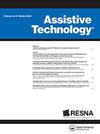无障碍文化遗产体验的RTLS部署案例研究。
IF 2.5
4区 医学
Q1 REHABILITATION
引用次数: 0
摘要
为了在博物馆和其他公共区域部署实时定位系统(RTLS)进行用户交互,已经进行了许多研究来测量蓝牙低功耗(BLE)信标、超宽带(UWB)信标和GPS的有效性。然而,这些研究往往忽视了农村地区。本研究旨在研究这三种技术的有效性,以开发一个模块化、健壮、可扩展的实时定位系统,以促进可访问的交互式文化遗产(CH)体验,特别是在农村地区。就政府机构如何在未来最好地支持卫生保健应用的无障碍技术,提出了建议。本文章由计算机程序翻译,如有差异,请以英文原文为准。
A case study on RTLS deployment for the implementation of accessible cultural heritage experiences.
Many studies have been carried out to measure the effectiveness of Bluetooth Low Energy (BLE) Beacons, Ultra Wideband (UWB) Beacons, and GPS for the purposes of deploying Real-time Localisation Systems (RTLS) for user interactions in Museums and other public areas. However, rural areas are often neglected from these studies. This study looks to investigate the effectiveness of these three technologies for the purposes of developing a modular, robust, scalable Real-Time Localization System for facilitating accessible interactive Cultural Heritage (CH) experiences, particularly in rural areas. Recommendations are made as to how government bodies might best support accessible technology for CH applications going forward.
求助全文
通过发布文献求助,成功后即可免费获取论文全文。
去求助
来源期刊

Assistive Technology
REHABILITATION-
CiteScore
4.00
自引率
5.60%
发文量
40
期刊介绍:
Assistive Technology is an applied, scientific publication in the multi-disciplinary field of technology for people with disabilities. The journal"s purpose is to foster communication among individuals working in all aspects of the assistive technology arena including researchers, developers, clinicians, educators and consumers. The journal will consider papers from all assistive technology applications. Only original papers will be accepted. Technical notes describing preliminary techniques, procedures, or findings of original scientific research may also be submitted. Letters to the Editor are welcome. Books for review may be sent to authors or publisher.
 求助内容:
求助内容: 应助结果提醒方式:
应助结果提醒方式:


